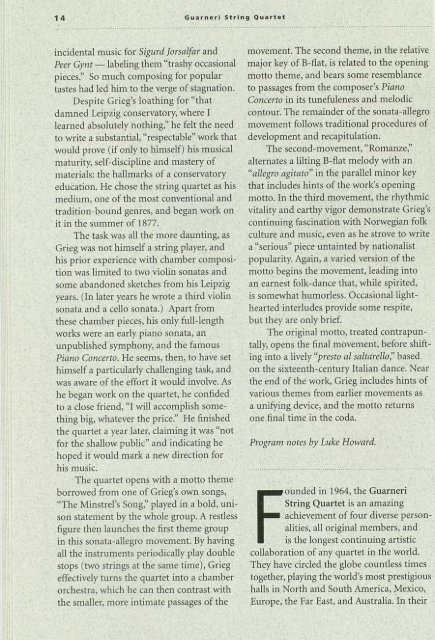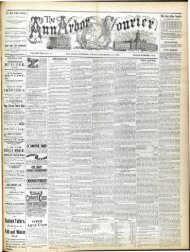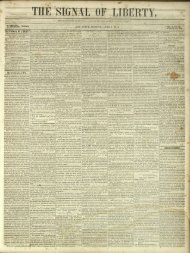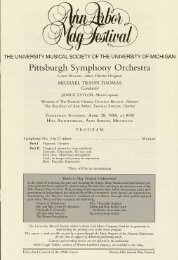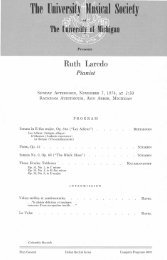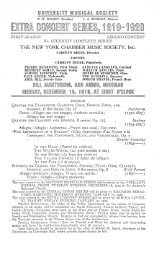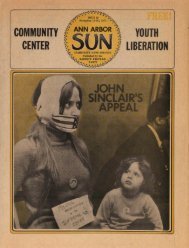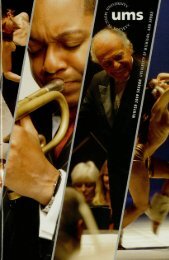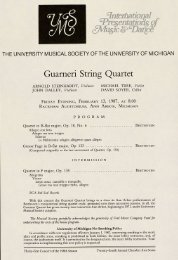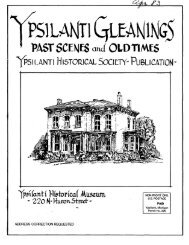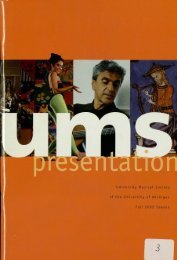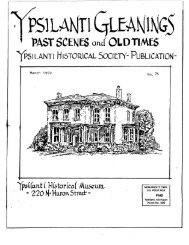University Musical Society - Ann Arbor District Library
University Musical Society - Ann Arbor District Library
University Musical Society - Ann Arbor District Library
You also want an ePaper? Increase the reach of your titles
YUMPU automatically turns print PDFs into web optimized ePapers that Google loves.
14 Guarneri String Quartet<br />
incidental music for Sigurd Jorsalfar and<br />
Peer Gynt— labeling them "trashy occasional<br />
pieces." So much composing for popular<br />
tastes had led him to the verge of stagnation.<br />
Despite Grieg's loathing for "that<br />
damned Leipzig conservatory, where I<br />
learned absolutely nothing," he felt the need<br />
to write a substantial, "respectable" work that<br />
would prove (if only to himself) his musical<br />
maturity, self-discipline and mastery of<br />
materials: the hallmarks of a conservatory<br />
education. He chose the string quartet as his<br />
medium, one of the most conventional and<br />
tradition-bound genres, and began work on<br />
it in the summer of 1877.<br />
The task was all the more daunting, as<br />
Grieg was not himself a string player, and<br />
his prior experience with chamber composi<br />
tion was limited to two violin sonatas and<br />
some abandoned sketches from his Leipzig<br />
years. (In later years he wrote a third violin<br />
sonata and a cello sonata.) Apart from<br />
these chamber pieces, his only full-length<br />
works were an early piano sonata, an<br />
unpublished symphony, and the famous<br />
Piano Concerto. He seems, then, to have set<br />
himself a particularly challenging task, and<br />
was aware of the effort it would involve. As<br />
he began work on the quartet, he confided<br />
to a close friend, "I will accomplish some<br />
thing big, whatever the price." He finished<br />
the quartet a year later, claiming it was "not<br />
for the shallow public" and indicating he<br />
hoped it would mark a new direction for<br />
his music.<br />
The quartet opens with a motto theme<br />
borrowed from one of Grieg's own songs,<br />
"The Minstrel's Song," played in a bold, uni<br />
son statement by the whole group. A restless<br />
figure then launches the first theme group<br />
in this sonata-allegro movement. By having<br />
all the instruments periodically play double<br />
stops (two strings at the same time), Grieg<br />
effectively turns the quartet into a chamber<br />
orchestra, which he can then contrast with<br />
the smaller, more intimate passages of the<br />
movement. The second theme, in the relative<br />
major key of B-flat, is related to the opening<br />
motto theme, and bears some resemblance<br />
to passages from the composer's Piano<br />
Concerto in its tunefuleness and melodic<br />
contour. The remainder of the sonata-allegro<br />
movement follows traditional procedures of<br />
development and recapitulation.<br />
The second-movement, "Romanze,"<br />
alternates a lilting B-flat melody with an<br />
"allegro agitato" in the parallel minor key<br />
that includes hints of the work's opening<br />
motto. In the third movement, the rhythmic<br />
vitality and earthy vigor demonstrate Grieg's<br />
continuing fascination with Norwegian folk<br />
culture and music, even as he strove to write<br />
a "serious" piece untainted by nationalist<br />
popularity. Again, a varied version of the<br />
motto begins the movement, leading into<br />
an earnest folk-dance that, while spirited,<br />
is somewhat humorless. Occasional light-<br />
hearted interludes provide some respite,<br />
but they are only brief.<br />
The original motto, treated contrapun-<br />
tally, opens the final movement, before shift<br />
ing into a lively "presto al saltarello" based<br />
on the sixteenth-century Italian dance. Near<br />
the end of the work, Grieg includes hints of<br />
various themes from earlier movements as<br />
a unifying device, and the motto returns<br />
one final time in the coda.<br />
Program notes by Luke Howard.<br />
Founded in 1964, the Guarneri<br />
String Quartet is an amazing<br />
achievement of four diverse person<br />
alities, all original members, and<br />
is the longest continuing artistic<br />
collaboration of any quartet in the world.<br />
They have circled the globe countless times,<br />
together, playing the world's most prestigious-<br />
halls in North and South America, Mexico,<br />
Europe, the Far East, and Australia. In their


